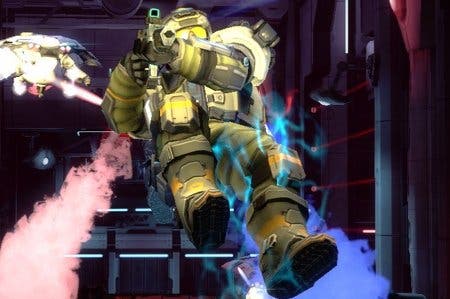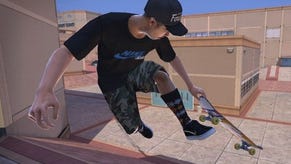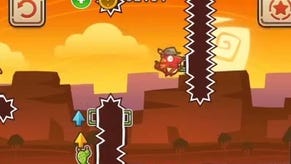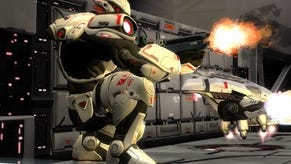Hybrid Review
Learning to fly.
Developer 5th Cell has a track record for thinking, as business gimps are fond of saying, outside of the box. Their Scribblenauts games took the frankly insane idea of allowing players to conjure up anything they could think of and somehow made it work. Hybrid represents a stylistic reversal from Scribblenauts - it's a futuristic, online third-person shooter, not a cartoon puzzler - but that same compulsion to reinvent remains.
The setting is broad and generic. It's the future. Mankind is under siege from alien invaders known as Variants, and fights back with the military might of the Paladins. Everyone is after Dark Matter, for reasons that are never fully explained. That's your back-story, now off you go like a good little soldier.
Gameplay takes the form of short, punchy three-a-side squad matches. Modes take all the forms you expect, with base capturing, bomb planting and lots and lots of Team Deathmatch. What's different is the movement, or rather the lack of it. You have a jetpack, but can only fly from one cover spot to another. There's no way of walking or moving outside of cover. At all.
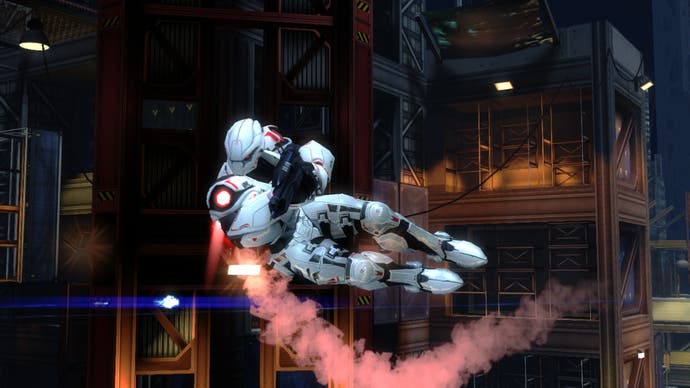
It sounds bizarre and horrible, but in practice it works surprisingly well. A concise tutorial fills you in on the basic controls, but they're intuitive enough for that to be all you need. Look at where you want to go, tap the A button and you jet off towards it. Even if the cover is on a wall or ceiling, you can attach to it. While in the air, you can strafe around, use a little turbo boost and even select a different cover point entirely if you want to change direction. Once in cover, the Y button allows you to hop over to the other side, while left and right allow you to shuffle along, ensuring you can stay reasonably safe even when flanked.
Despite the emphasis on cover, the pace is fast. Even the standard weapon loadout is capable of finishing you off in a few shots, while additional abilities, various grenades and stat-buffing specialisations up the ante further.
Killstreaks are rewarded with three remote drones. The basic Stalker model, unlocked after one kill, will follow you around and fire on any enemies. It's weak, but better than nothing. The Warbringer is as brutal as its name suggests, an aggressive combat machine with heavy armour and weaponry that becomes available after three kills. Finally, there's the Preyon, unlocked after a five-kill streak. This lady ninja robot is the game's equivalent of Mario Kart's blue shell. Let it loose and it screams after the nearest enemy, and only those with fast trigger fingers and a fair amount of luck will survive the encounter.

It all adds up to a robust shooter framework, but it never really justifies its curious control decisions. It doesn't take long to get used to the unusual movement, but there are still moments where you'll die purely because the game won't allow you full freedom to dodge and duck as you please. This would be easier to bear if the cover-or-nothing approach brought with it some revelatory gameplay, but it never really does. While it's perfectly workable, it always feels like change for change's sake, rather than a twist on convention that opens up new gameplay possibilities.
In fact, the game's biggest drawback isn't down to the limited movement being difficult to master, but the flattening effect it has on the maps. Each one simply becomes a circuit of cover spots, all made from the same identical barriers, with the only distinguishing features being whatever nominal backdrop has been chosen. There are no tricks or tactics unique to each map, just a constant cycle of duck-and-cover, cat-and-mouse action. There's just no variety, and even after playing over 50 matches I'd be hard pushed to tell you the practical difference between, say, the Airfield map and the one called Cache.
This, coupled with the community's natural tendency towards straight Team Deathmatch play, means that Hybrid has a very low gameplay ceiling, and déjà vu sets in all too quickly. Had the game offered larger squads, more complex maps and more nuanced objectives, there'd be more incentive to use the more exotic weapons and try more interesting strategies. With its emphasis on cover, it feels like it should be a more tactical game, but it never grows beyond the hit-and-run pace of a snack-sized twitch shooter. That's a problem, since the game has a focus on long-term goals thanks to its persistent world map.
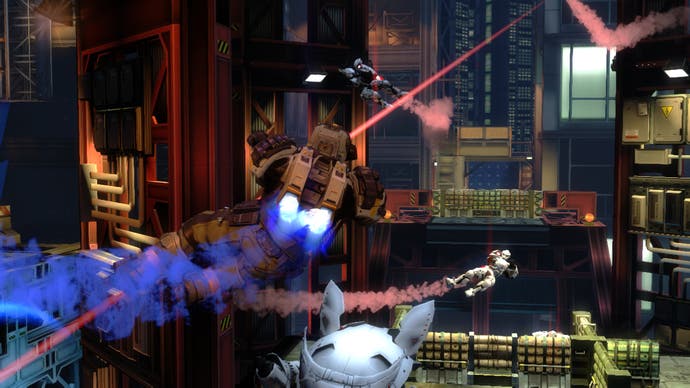
You're taking part in an ongoing global war, you see, with all the continents (except Australia, bizarrely) broken down further into districts. The more a faction dominates a district, the closer they come to claiming its supply of Dark Matter samples. This is important because the first faction to claim 100 samples wins the war. The game does a poor job of explaining this, however, and makes even less effort to explain why you, as an individual player concentrating on your own levelling up, should be bothered by this sea of percentages and numbers. There's a disconnect between the overarching meta-game and the round-by-round rank progression that leaves advancement feeling a little vague.
Also sure to raise eyebrows is the decision to allow players to unlock any weapon and ability at any point by purchasing in-game credits with Microsoft Points. Virtual currency buys virtual currency which buys kit that would otherwise have to be earned piecemeal at each skill rank.
It's a problem, but not a fatal one. Hybrid still justifies its asking price in the moment, with crisp 60-frames-per-second action and satisfying feedback. It's a solid, enjoyable shooter, but one that ultimately fails to leverage its strange control decisions into a truly unique experience. It should be different yet, for all its bold ideas about movement, it ends up feeling strangely generic over the long haul. Recommended, then, but far from essential.
